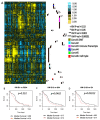Treatment Combining CD200 Immune Checkpoint Inhibitor and Tumor-Lysate Vaccination after Surgery for Pet Dogs with High-Grade Glioma
- PMID: 30682795
- PMCID: PMC6406711
- DOI: 10.3390/cancers11020137
Treatment Combining CD200 Immune Checkpoint Inhibitor and Tumor-Lysate Vaccination after Surgery for Pet Dogs with High-Grade Glioma
Abstract
Recent advances in immunotherapy have included inhibition of immune checkpoint proteins in the tumor microenvironment and tumor lysate-based vaccination strategies. We combined these approaches in pet dogs with high-grade glioma. Administration of a synthetic peptide targeting the immune checkpoint protein, CD200, enhanced the capacity of antigen-presenting cells to prime T-cells to mediate an anti-glioma response. We found that in canine spontaneous gliomas, local injection of a canine-specific, CD200-directed peptide before subcutaneous delivery of an autologous tumor lysate vaccine prolonged survival relative to a historical control treated with autologous tumor lysate alone (median survivals of 12.7 months and 6.36 months, respectively). Antigen-presenting cells and T-lymphocytes primed with this peptide suppressed their expression of the inhibitory CD200 receptor, thereby enhancing their ability to initiate immune reactions in a glioblastoma microenvironment replete with the immunosuppressive CD200 protein. These results support consideration of a CD200 ligand as a novel glioblastoma immunotherapeutic agent.
Keywords: dogs; glioma; immunotherapy; tumor lysate.
Conflict of interest statement
Olin and Moertel are co-founders and major shareholders in OX2 Therapeutics.
Figures




Similar articles
-
Cancel cancer: The immunotherapeutic potential of CD200/CD200R blockade.Front Oncol. 2023 Jan 23;13:1088038. doi: 10.3389/fonc.2023.1088038. eCollection 2023. Front Oncol. 2023. PMID: 36756156 Free PMC article. Review.
-
CD200 Checkpoint Reversal: A Novel Approach to Immunotherapy.Clin Cancer Res. 2020 Jan 1;26(1):232-241. doi: 10.1158/1078-0432.CCR-19-2234. Epub 2019 Oct 17. Clin Cancer Res. 2020. PMID: 31624103
-
CD200 depletion in glioma enhances antitumor immunity and induces tumor rejection.bioRxiv [Preprint]. 2024 Sep 10:2024.09.08.611922. doi: 10.1101/2024.09.08.611922. bioRxiv. 2024. PMID: 39314283 Free PMC article. Preprint.
-
Tumor-derived vaccines containing CD200 inhibit immune activation: implications for immunotherapy.Immunotherapy. 2016 Sep;8(9):1059-71. doi: 10.2217/imt-2016-0033. Immunotherapy. 2016. PMID: 27485078 Free PMC article.
-
Emerging Immune Checkpoint Molecules on Cancer Cells: CD24 and CD200.Int J Mol Sci. 2023 Oct 11;24(20):15072. doi: 10.3390/ijms242015072. Int J Mol Sci. 2023. PMID: 37894750 Free PMC article. Review.
Cited by
-
Trap and ambush therapy using sequential primary and tumor escape-selective oncolytic viruses.Mol Ther Oncolytics. 2023 May 22;29:129-142. doi: 10.1016/j.omto.2023.05.006. eCollection 2023 Jun 15. Mol Ther Oncolytics. 2023. PMID: 37313455 Free PMC article.
-
Cancel cancer: The immunotherapeutic potential of CD200/CD200R blockade.Front Oncol. 2023 Jan 23;13:1088038. doi: 10.3389/fonc.2023.1088038. eCollection 2023. Front Oncol. 2023. PMID: 36756156 Free PMC article. Review.
-
Breed-Associated Differences in Differential Gene Expression Following Immunotherapy-Based Treatment of Canine High-Grade Glioma.Animals (Basel). 2024 Dec 26;15(1):28. doi: 10.3390/ani15010028. Animals (Basel). 2024. PMID: 39794971 Free PMC article.
-
A novel system to map protein interactions reveals evolutionarily conserved immune evasion pathways on transmissible cancers.Sci Adv. 2020 Jul 1;6(27):eaba5031. doi: 10.1126/sciadv.aba5031. Print 2020 Jul. Sci Adv. 2020. PMID: 32937435 Free PMC article.
-
Single-cell T-cell receptor repertoire profiling in dogs.Commun Biol. 2024 Apr 22;7(1):484. doi: 10.1038/s42003-024-06174-w. Commun Biol. 2024. PMID: 38649520 Free PMC article.
References
Grants and funding
LinkOut - more resources
Full Text Sources
Other Literature Sources

